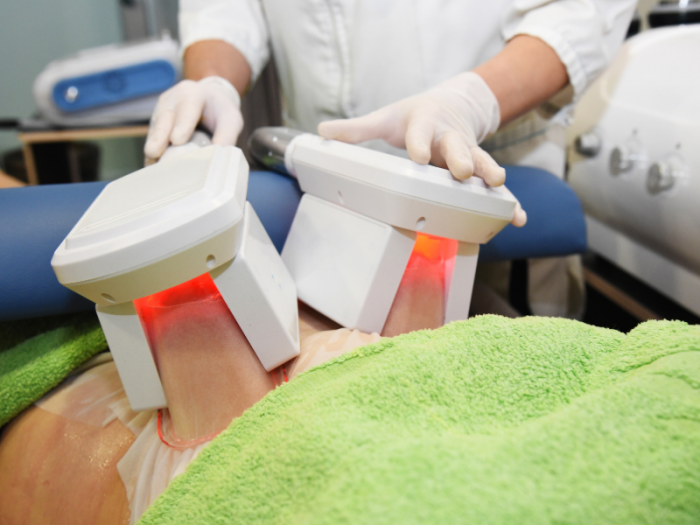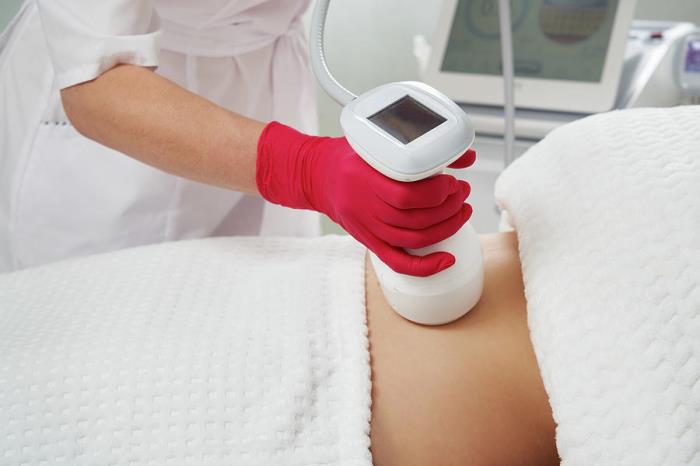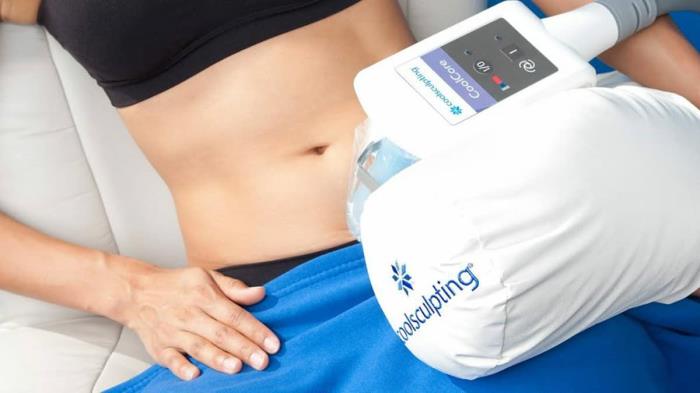Non-surgical tummy tuck solutions are designed for individuals seeking to tone and tighten the abdominal area without undergoing invasive surgery. These methods primarily target excess fat and sagging skin using advanced technologies such as laser treatments, radiofrequency, and ultrasound therapy. The results are gradual and typically involve multiple treatment sessions, making it a popular option for those looking for minimal downtime, less risk, and a more natural approach to body contouring.
Unlike traditional tummy tucks, which involve incisions and removal of excess skin and fat, non-surgical solutions focus on stimulating the body’s natural processes to firm the skin and reduce fat.
How Non-Surgical Treatments Differ from Traditional Tummy Tucks
Non-surgical treatments differ significantly from traditional tummy tucks in terms of invasiveness, recovery, and results. A traditional tummy tuck is a surgical procedure where a surgeon removes excess skin and fat, tightens the abdominal muscles, and may reposition the belly button. This procedure requires general anesthesia, carries surgical risks, and involves a recovery period that may last several weeks.
On the other hand, non-surgical treatments involve external devices or injectables that stimulate fat reduction or skin tightening without making incisions. The recovery time for non-surgical options is minimal, often allowing patients to return to normal activities almost immediately. However, non-surgical methods usually require multiple sessions to achieve noticeable results and are best suited for individuals with less extensive needs.
Is Non-Surgical Body Contouring Right for You?
Non-surgical body contouring may be right for you if you have mild to moderate skin laxity or pockets of stubborn fat that do not respond to diet and exercise. Candidates for these treatments are generally close to their ideal body weight and are looking for subtle improvements rather than dramatic transformations. It's important to have realistic expectations, as non-surgical methods cannot replicate the results of surgery but can offer a non-invasive alternative with less risk and downtime.

People with significant skin sagging or larger amounts of excess fat may not be ideal candidates for non-surgical body contouring. In these cases, a traditional surgical tummy tuck or liposuction may provide more satisfactory results. Consulting with a qualified specialist can help determine whether non-surgical options align with your aesthetic goals.
Popular Non-Surgical Tummy Tightening Techniques
Several popular non-surgical techniques for tummy tightening are available today, each using different technologies to target skin laxity and fat reduction. Radiofrequency treatments like Thermage and Venus Freeze use heat energy to stimulate collagen production and firm the skin. Ultrasound-based therapies, such as Ultherapy, use sound waves to penetrate deep layers of the skin, promoting tightening and contouring over time.
CoolSculpting is another widely used technique that freezes and eliminates fat cells through cryolipolysis, particularly effective for reducing fat in the abdominal area. These methods are non-invasive, require little to no downtime, and generally offer gradual improvements over the course of several sessions.
Laser Treatments for Abdominal Skin Tightening
Laser treatments for abdominal skin tightening, such as Fraxel and CoolLaser, utilize concentrated light energy to stimulate collagen production and reduce skin laxity. These treatments are particularly effective for individuals with mild to moderate skin sagging in the abdominal region. By heating the deeper layers of the skin, laser treatments encourage the body’s natural healing processes to create a firmer, smoother appearance.
While laser skin tightening is non-invasive and usually has minimal recovery time, it may cause some temporary redness or swelling. Depending on the extent of skin laxity, multiple sessions may be required to achieve optimal results. Laser treatments are most suitable for patients who want to enhance skin tone and texture without the need for surgery.
Radiofrequency for a Flatter Stomach Without Surgery
Radiofrequency (RF) treatments use energy waves to heat the deep layers of the skin, promoting collagen production and fat reduction. This method is popular for achieving a flatter stomach without surgery because it tightens the skin and reduces localized fat deposits. RF treatments are painless, require no downtime, and results can often be seen after a few sessions. Patients may opt for this treatment as a non-invasive alternative to traditional liposuction, although results are usually subtler and require multiple sessions for optimal outcomes.

The Role of Ultrasound in Non-Surgical Tummy Tucks
Ultrasound technology is used in non-surgical tummy tucks to break down fat cells without damaging the surrounding tissues. This process, often referred to as ultrasound cavitation, works by delivering sound waves deep into the skin layers, disrupting fat cells that are later eliminated through the body's natural processes. While it doesn’t offer the dramatic results of a surgical tummy tuck, it helps contour the abdomen with minimal discomfort and no recovery time, making it an appealing choice for those seeking gradual and subtle improvements.
Cryolipolysis (CoolSculpting) for Stubborn Belly Fat
Cryolipolysis, commonly known as CoolSculpting, is a non-invasive procedure designed to target and eliminate stubborn fat by freezing fat cells. The treated fat cells die off and are naturally processed and removed by the body. CoolSculpting is particularly effective for belly fat that is resistant to diet and exercise. The treatment requires no downtime, and patients can return to daily activities immediately. Visible results generally appear within a few months, making it a popular choice for those seeking fat reduction without surgery.

Injections for Fat Reduction: Are They Effective?
Fat-reducing injections, such as deoxycholic acid (Kybella), work by breaking down fat cells in targeted areas, which are then naturally eliminated by the body. These injections can be effective for small areas of fat, such as under the chin or in localized abdominal regions. However, the effectiveness varies based on the individual’s body type and treatment area. Multiple sessions may be required to achieve noticeable results. While injections offer a non-surgical alternative, they are typically less effective for large volumes of fat compared to other methods like CoolSculpting or radiofrequency.
Comparing Non-Surgical Tummy Tightening Results to Surgical Outcomes
Non-surgical tummy tightening options, such as radiofrequency or ultrasound treatments, offer a less invasive approach compared to traditional surgical tummy tucks. However, the results are generally more subtle and take longer to become apparent. Surgical tummy tucks provide immediate and more dramatic results, particularly in cases of excess skin or muscle separation. Non-surgical treatments are ideal for individuals with mild skin laxity or fat, while surgical options are recommended for those seeking significant changes in body contour. Non-surgical methods require more maintenance to sustain results.
Recovery Time for Non-Surgical Procedures
Non-surgical abdominal treatments typically involve minimal recovery time compared to surgical options. Procedures such as CoolSculpting, radiofrequency, or ultrasound require little to no downtime, allowing patients to return to normal activities immediately or within a day. There may be mild side effects, like swelling, bruising, or redness, but these usually subside within a few days. This short recovery time makes non-surgical procedures appealing for individuals who want to avoid the extended downtime associated with surgeries like abdominoplasty.
Benefits of Non-Invasive Tummy Tuck Alternatives
Non-invasive tummy tuck alternatives provide several key benefits, including minimal discomfort, no need for anesthesia, and reduced recovery time. These procedures, which include radiofrequency, ultrasound, and cryolipolysis, are less risky than traditional surgery and offer a more gradual and natural-looking improvement. They are also more affordable than surgical options and can target specific areas of concern with fewer complications. These methods appeal to individuals seeking a less invasive way to tone and contour their abdomen without undergoing a full surgical procedure.
Risks and Side Effects of Non-Surgical Abdominal Treatments
Although non-surgical abdominal treatments are generally safer than surgery, they still come with some risks and side effects. Common side effects include temporary swelling, redness, bruising, and discomfort in the treated area. In rare cases, there can be more severe side effects such as burns from radiofrequency devices or paradoxical adipose hyperplasia after cryolipolysis, where fat cells increase instead of decrease. It is important for patients to consult with qualified professionals to assess their suitability for these procedures and to minimize the risk of complications.
How Long Do Non-Surgical Results Last?
The longevity of non-surgical tummy tightening results varies depending on the treatment used and the individual’s lifestyle. Treatments like CoolSculpting and radiofrequency can produce results that last for several months to a few years, especially when combined with a healthy diet and regular exercise. However, maintenance treatments may be required to sustain the desired look, as the natural aging process and weight fluctuations can impact the results over time. While non-surgical procedures do not provide permanent results, they can offer long-lasting improvements with proper care.
Cost Comparison: Non-Surgical vs. Surgical Tummy Tuck
The cost of non-surgical tummy tuck alternatives is generally lower than traditional surgical tummy tucks. Non-surgical procedures, such as CoolSculpting, radiofrequency, or ultrasound, can range from a few hundred to a few thousand dollars per session, depending on the treatment area and number of sessions required. In contrast, surgical tummy tucks can cost between $6,000 and $12,000, including anesthesia and hospital fees. While non-surgical options are less expensive, they may require multiple sessions to achieve the desired results, potentially increasing the total cost over time.
Maintaining Results After Non-Surgical Tummy Tightening
Maintaining results after non-surgical tummy tightening involves adopting a healthy lifestyle that includes a balanced diet and regular exercise. Staying hydrated and managing weight fluctuations can significantly prolong the effects of treatments such as CoolSculpting or radiofrequency. Additionally, routine follow-up sessions may be necessary to sustain optimal results, as the natural aging process and skin elasticity can impact the appearance of the abdomen over time. It is also beneficial to incorporate skin care practices, like moisturizing and using sun protection, to enhance skin health and firmness.
Combining Non-Surgical Methods for Enhanced Results
Combining non-surgical methods can enhance overall results and address various aspects of body contouring. For instance, a patient might use CoolSculpting to target stubborn fat areas while incorporating radiofrequency treatments to tighten skin simultaneously. This multi-faceted approach can lead to a more comprehensive transformation, allowing for improved fat reduction and skin tightening in a single treatment plan. Collaborating with a qualified practitioner to design a customized combination treatment can optimize outcomes and cater to the unique needs and goals of each patient.
Ideal Candidates for Non-Surgical Tummy Tuck Alternatives
Ideal candidates for non-surgical tummy tuck alternatives typically include individuals who have mild to moderate skin laxity or localized fat but do not require extensive surgical intervention. These candidates should be in good overall health, maintain a stable weight, and have realistic expectations regarding the results. Non-surgical methods are particularly suited for those looking for subtle improvements without the risks and downtime associated with surgery. Consulting with a qualified practitioner can help determine the best treatment options for each individual’s specific needs and aesthetic goals.
What to Expect During a Non-Surgical Tummy Tightening Procedure
During a non-surgical tummy tightening procedure, patients can expect a straightforward process tailored to their chosen method. For example, during a CoolSculpting session, a gel pad is applied to the treatment area, followed by the application of a device that cools the fat cells. Patients often experience a sensation of cold followed by numbness, with no anesthesia required. The session typically lasts between 30 to 60 minutes, and individuals can return to their daily activities immediately afterward. Post-treatment effects may include mild swelling or redness, which generally resolve quickly.
Expert Tips for Choosing the Right Non-Surgical Tummy Treatment
When selecting the right non-surgical tummy treatment, it is essential to consult with a qualified and experienced practitioner who can assess individual needs and recommend suitable options. Consider factors such as the specific area of concern, desired results, and any pre-existing health conditions. Researching various techniques, understanding potential side effects, and asking for before-and-after photos of previous patients can also inform the decision-making process. Additionally, exploring reviews and testimonials can provide insights into the experiences of others and help ensure a positive treatment outcome.
Can a Tummy Tuck Address Diastasis Recti?
Discover how a tummy tuck procedure can effectively treat diastasis recti, a condition where the abdominal muscles separate, often as a result of pregnancy. This surgery not only tightens the muscles but also improves the overall strength and appearance of the abdominal area, helping patients regain their pre-pregnancy shape and reduce back pain associated with the condition.
The Relationship Between Obesity and the Need for a Tummy Tuck
Understand the complex relationship between obesity and the decision to undergo a tummy tuck. Excessive weight gain can lead to stretched skin, fat deposits, and weakened muscles in the abdominal area, often requiring surgical intervention to restore a flatter, more toned appearance. This procedure not only improves aesthetics but can also have health benefits, including enhanced mobility and confidence.
Best Tummy Tuck Surgery in India
The Best Tummy Tuck Surgery in India offers patients a solution to achieve a flatter abdomen through advanced surgical techniques, improving body contour and enhancing confidence.
Best Tummy Tuck Hospitals in India
The Best Tummy Tuck Hospitals in India provide state-of-the-art facilities with skilled medical teams, ensuring comprehensive care that includes personalized pre-operative consultations and diligent post-operative support.
Tummy Tuck Surgery Cost in India
The Tummy Tuck Surgery Cost in India is designed to be accessible, offering competitive pricing while upholding high standards of safety and care at renowned hospitals.
Best Tummy Tuck Surgeons in India
The Best Tummy Tuck Surgeons in India are highly trained professionals specializing in body contouring, employing precise techniques to deliver optimal results tailored to individual patient needs.
FAQs for Non-Surgical Options for Tummy Tuck Surgery
Are non-surgical tummy tucks as effective as surgery?
Non-surgical tummy tucks can offer noticeable improvements but are generally not as effective as surgical options. Surgical tummy tucks provide more dramatic results, especially for individuals with significant skin laxity or excess fat. Non-surgical methods tend to be better suited for those seeking subtle changes or who are not ready for invasive procedures. The effectiveness of non-surgical treatments varies based on individual goals and body types.
How many sessions are needed for non-surgical treatments?
The number of sessions required for non-surgical treatments varies depending on the specific method used and the desired results. For instance, CoolSculpting typically requires two to three sessions spaced several weeks apart to achieve optimal results. Radiofrequency treatments may also require multiple sessions to enhance skin tightening effects. A consultation with a qualified practitioner can provide a personalized treatment plan outlining the recommended number of sessions.
Is there any downtime for non-surgical tummy tuck procedures?
One of the main advantages of non-surgical tummy tuck procedures is that they typically involve little to no downtime. Most patients can return to their normal activities immediately after treatment, although some may experience mild swelling, redness, or bruising in the treated area. These side effects are usually temporary and resolve quickly, allowing individuals to resume their daily routines without significant interruption.
What are the long-term effects of non-surgical body contouring?
The long-term effects of non-surgical body contouring can be positive, with results lasting for several months to years, depending on the treatment method and individual lifestyle. Maintenance treatments may be necessary to prolong results, particularly as natural aging and weight fluctuations can affect the appearance of the abdomen. Overall, a commitment to a healthy lifestyle can help sustain the benefits of non-surgical body contouring.
Can non-surgical treatments remove loose skin after pregnancy or weight loss?
Non-surgical treatments can help improve skin firmness and elasticity, but they may not completely remove loose skin resulting from pregnancy or significant weight loss. Procedures like radiofrequency and ultrasound can tighten the skin to some extent, making them suitable for mild to moderate laxity. However, individuals with more severe skin sagging may still require surgical intervention to achieve desired results. Consulting with a qualified practitioner can help determine the best approach based on individual circumstances.